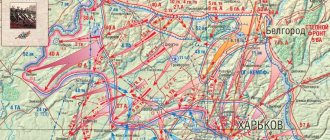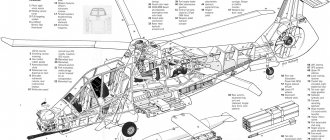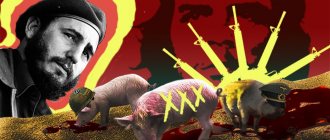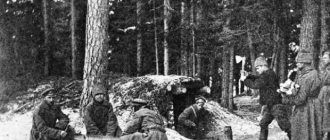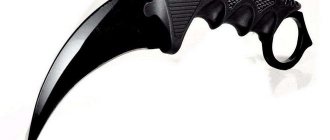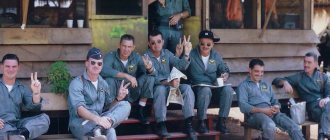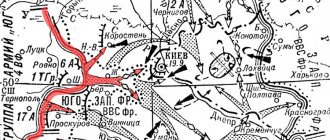On April 25, 1980, in Tehran, a raging crowd of religious fanatics threw eight corpses of American military personnel into the square in front of the US Embassy under the guns of journalists' television cameras: sing Air Force pilots and three US Marine Corps aviation pilots. Later, all television channels around the world showed the wreckage of the plane and helicopter, as well as three entire RH-53D Sea Stellion helicopters, which remained forever in the Iranian desert. Thus ended the attempt of the anti-terrorist group Delta to free 54 hostages taken on November 4, 1979 at the American embassy by Iranian Revolutionary Guards with the decisive blessing of Ayatollah Khomeini.
BACKGROUND: DELTA FORCE
The history of Delta begins in the 60s, when the command of the American Green Berets entered into an agreement with the British SAS (three separate regiments of the SAS special aviation service formed the basis of the British special operations forces) on the mutual exchange of people. The first American to go to England was the commander of the 7th Green Beret group, Colonel Edwards, and the next year Captain Charles Beckwith went there. In July 1962, he arrived at the 22nd SAS Regiment, where he experienced first-hand the entire complex system of selection and training of personnel, developed by the British 21 years ago and subsequently improved.
The first discovery that Beckwith made was this: the right to wear a beret with the SAS emblem must be earned through a lot of sweat and blood. Suffice it to say that only the verification tests in the SAS regiment are divided into five stages and take six months.
Returning from England in 1963, Beckwith began to convince his leadership of the need to create a special unit similar to the SAS. The command responded to Beckwith's proposal. A small detachment was created, codenamed "Blue Light". The “ideological organizer and inspirer” himself ended up in Vietnam, where he was allowed to form a detachment modeled on the SAS. The Beckwith group of the body is called “D”. She successfully participated in many operations against the Viet Cong. In Vietnam, Beckwith was wounded in the stomach and fell three times in downed helicopters, but survived. On November 21, 1970, Beckwith participated in an operation to free American prisoners from the San Pai camp near Hanoi. The operation was played out like clockwork, but there were no prisoners in the camp.
Vietnam ended and the era of international terrorism began. All this time, Beckwith was haunted by the idea of creating an American analogue of SAS. Beckwith’s idea received a new impetus after the successful operation carried out by the German GHA-9 group to free the plane in Mogadishu. Not wanting to lag behind Germany, the White House gave the green light to the anti-terrorist fight. Beckwith began to create a special unit, which, in memory of his unit during the Vietnam War, he called “Delta”.
It took two years to form and prepare Delta. It turned out to be a copy of the English SAS, adjusted for the United States. The Americans were mainly trained by SAS experts, imparting experience in the fight against terrorism. And just when Delta was on its feet, news came: the US Embassy in Iran had been captured, and fifty-four US State Department employees were taken hostage.
Victims
- 19 June: On the first day of the operation, one British soldier, a Major in the 1st Battalion Welsh Guards, was killed in an explosion near Lashkar Gah.
- 23 June: Lieutenant Colonel Richardson of Task Force Helmand reported that British forces had killed several Taliban fighters during operations around Babaji.[8]
- 1 July: A Danish sabotage attack was stopped by pockets of resistance and sniper fire. While clearing an area to be used as a camp for the night, one Danish soldier was severely wounded when he knelt down and activated the pressure plate of an IED.
- July 1: two British soldiers - Lieutenant Colonel. Rupert Thorneloe, commander of the 1st Battalion Welsh Guards and President Joshua Hammond of the 2nd Royal Tank Regiment, was killed and six wounded near the Shamalan Canal in Lashkar Gah when a BvS 10 Viking armored vehicle hit them.[28][29] Lieutenant Colonel Thorneloe is the most senior officer in the British Army. killed in action as Lieutenant Colonel 'CHAS'. Jones in the Falklands War and the highest-ranking casualty in Afghanistan.[23][29]
- 4 July: Two more British soldiers were killed, one from the 2nd Battalion Mercian Regiment. rocket-propelled grenade and a second one from the Light Dragoons, using an IED, nearby Gereshk.[30]
- 5 July: A member of the 1st Battalion Welsh Guards was killed in an explosion near Lashkar Gah.[31]
- 7 July: A member of the Light Dragoons was killed in an explosion near Gereshk.[32]
- 9–10 July: The Ministry of Defense announced that eight British soldiers had died within 24 hours, bringing the total number of British armed forces personnel killed in Afghanistan since 2001 to 184. A further 30 soldiers were wounded during this 24-hour period . Three of these soldiers were killed in support of Operation Panther Claw.[33][34]
- 16 July: A member of the 2nd Rifles Battalion was killed in an explosion near Gereshk.
"POT OF RICE"
From that moment on, preparations began for the operation to free the hostages. By order of the Chairman of the Joint Chiefs of Staff, General David Jones, a temporary combined arms tactical group was created from representatives of the Army, Air Force, Navy and Marine Corps. The planning and preparation stage of the hostage rescue operation was codenamed “Pot of Rice”, and the operation itself on Iranian territory was called “Eagle Claw”. Major General James Voth was appointed commander of the group, and Air Force Major General Philip Gast was his deputy for aviation affairs. Colonel Beckwith and Air Force Colonel Kyle were directly involved in the development of the operation. Both of them had extensive experience in planning special operations, but due to the prevailing circumstances they could not resist the instructions of Generals Voth and Gast, who often expressed the wrong judgment or agreed with dubious recommendations.
The first damn thing is lumpy
When all the participants in the upcoming operation gathered at the airfield, the commander of the Delta unit, Charlie Beckwith, regretfully stated that out of eight helicopters only five remained in working order. At the same time, the colonel understood perfectly well that if the first combat operation failed, the special unit would be disbanded, and he himself would have to report to his superiors for the high-profile fiasco. It was easier to refuse the operation for technical reasons, but at the same time saving face. However, higher powers obviously thought differently. The special forces boarded the planes. But the takeoff of one of them was prevented by a helicopter standing in the way. The screws started working. Dust rose. Not seeing each other in the sand cloud, both air machines moved forward. A terrible blow followed. The working blades of the helicopter tore through the skin of the Hercules transport vehicle. Naturally, he could no longer take off. As a result, a fire broke out. As the fire spread, ammunition in the tail of the plane began to explode. During the incident, the US Army lost five crew members and three helicopter pilots. From the outside it seemed that the first Delta operation was cursed by someone. Everything the special forces did was in vain. It is not surprising that the departure of the Americans from the Iranian desert on the remaining transport planes looked more like a stampede. It got to the point that the helicopters located near the exploded Hercules remained abandoned, in which secret equipment and papers with orders to carry out the operation remained. The result of the “Eagle Claw” was the loss of several aircraft and military personnel without any combat with the enemy. In a word, a complete failure! The creator of Delta, Charles Beckwith, resigned with scandal, and the hostages from the American embassy were rescued through diplomatic negotiations. The new US President was not Jimmy Carter, but former film actor Ronald Reagan.
Magazine: War and Fatherland No. 7, July 2022 Category: In hot countries Author: Dmitry Sokolov
Tags: War and Fatherland, USA, Iran, Tehran, special forces, 1979, intelligence service, Middle East, Dmitry Sokolov
- Back
- Forward
OPERATION PLAN "EAGLE CLAW"
The plan for the release of the hostages was as follows: two Delta squadrons and a company of Rangers on three C-130 Hercules aircraft with attached refueling aircraft were to land at the Desert-1 point, which was located approximately 370 km southeast of Tehran . Eight RH-53D Sea Stellion helicopters, which were based on the Nimitz aircraft carrier located in the Persian Gulf, were also supposed to fly there. The difference between airplane and helicopter landings was supposed to be 30 minutes. After landing the Delta and refueling the helicopters, the Hercules planes were supposed to return to the departure airfield, and the helicopters were to deliver the Delta fighters to a pre-planned shelter near Tehran, which was two hours away by flight, and then fly to another point, 90 km from the Delta shelter, and remain there under camouflage nets throughout the next day.
Scheme of Operation Eagle Claw |
On the evening of April 25, CIA operatives, who had been dispatched to Iran in advance, had to deliver the Delta to the US Embassy in six trucks. Closer to midnight, the group was supposed to storm the embassy building: get to the windows along the outer walls, get inside, eliminate the guards and free the hostages. Then it was planned to call helicopters and evacuate either from the embassy territory or from the nearby football field. The evacuation was to be supported from the air by two AC-130H fire support aircraft.
In the early morning of April 26, the helicopters, having flown 65 km south, would have landed at the Manzariye airfield, which by that time was controlled by a company of Rangers. From there, the hostages were supposed to be flown to the United States on two C-141 jets, and the Rangers were supposed to return on C-130 planes.
All operational support for the operation was entrusted to the Central Intelligence Agency. The selection of landing sites, provision of transport, routes around the city - all these issues were worked out by CIA officers and brought to the attention of the participants in the operation.
ONE OF THE ELEMENTS
A full-scale mock-up of the Tehran embassy complex was built in Florida, and Delta began training. It was then that it was discovered that much was not taken into account in the proposed plan. For example, one of the important elements of the tactical troupe - the helicopter pilot - could fail. The fact is that the Navy command insisted that Navy pilots participate in the operation (motivation - army helicopters that do not have folding blades will not be able to fit on an aircraft carrier), and allocated crews of helicopters - sea minesweepers - for the operation. During the training, it turned out that the flight crews did not want to learn night and “blind” flights and were not eager to participate in the rescue of hostages). With great difficulty, Bzkvit managed to replace the Navy pilots with US Marine pilots. Things have moved forward. In total, Delta conducted 79 night training to free hostages; Beckwith was more or less calm, but did not fully trust the helicopter crews, believing that they could let them down.
"MURPHY'S LAW"
And after numerous approvals and modifications, the tactical group was ready to begin rescuing the hostages. On April 20, Delta and the Rangers in Hercules moved to Wadi Qena, a remote airfield in Egypt. The helicopters were relocated to the Nimitz, and on April 24 the group concentrated in the area of Masirah Island. Three hours after arriving at Masiru, the final command "Forward" was received. And then “Murphy’s law”, or, in Russian, “the law of the sandwich,” came into force. Helicopters taking off from Nimitz encountered a weather phenomenon known in Iran as "habub" - small particles of dust rising into the air. Visibility decreased to zero. Two of the eight helicopters went off course and returned to the aircraft carrier.
The second “pleasant” surprise awaited Beckwith, “Delta” and the rangers at the site * “Desert-1”. The site, prepared by CIA operatives, was located next to a busy highway, and the Americans were amazed at the sheer volume of traffic moving directly in front of the landing plane. In addition, almost all the rangers who were supposed to guard the perimeter were vomiting from the shaking in the air. Only two were able to control the motorcycles and, upon approaching the highway, they managed to stop the bus, taking its passengers and driver prisoner.
The rangers first shot at the truck moving behind the bus from a machine gun, and then launched a grenade from an under-barrel grenade launcher. A pillar of flame shot up into the night sky. It turns out they shot a fuel truck. The minibus following the truck turned around, picked up the driver of the fuel truck and sped away. One of the rangers on a motorcycle tried to catch up with him, but soon gave up the pursuit and turned back. It was impossible to catch up with the minibus.
Special forces against smugglers
Since Operation Eagle Claw from the very beginning was more like the filming of a blockbuster, the events during its conduct developed within the framework of this scenario. Late in the evening of April 24, 1980, transport planes with Delta personnel on board took off from an American military base in Oman. Special forces and rangers were placed in the first three Hercules, and three more aircraft carried fuel in special rubber tanks. Later, in order to reach the desired point at the estimated time, eight helicopters took off from the Nimitz aircraft carrier. The weather was the first to rebel against the Americans. Thick dust clouds hung over the desert. Their appearance was not a problem for transport aircraft. At the same time, helicopter pilots, caught in a dust storm, found themselves in conditions of almost zero visibility. The sand also had a detrimental effect on the technical condition of the air vehicles themselves. The temperature in the cabins rose, and mechanical components began to fail one after another. Helicopter No. 6 was the first to break down. The propeller blades stopped working, and the pilot literally miraculously managed to land the aircraft in the middle of the desert. The crew had to transfer to another helicopter. Next, malfunctions began in helicopter No. 5, in which the helicopter flight commander was located. Since the problems turned out to be quite serious, the aircraft returned to the aircraft carrier. Due to the impact of sand, only six of the eight helicopters reached the airfield located in the desert. The third aircraft broke down already on the Pustyn-1 runway. As a result, the possibility of a successful operation was in question. However, as it turned out later, the troubles for the Americans were just beginning. As soon as the transport planes with Delta personnel landed at the abandoned airfield, a bus with Iranians appeared on the road running past, it is unknown where and why, heading through the desert at night. The secrecy regime could not be violated. The bus was stopped and Washington asked what to do with the prisoners. Presidential National Security Advisor Zbigniew Brzezinski ordered the bus passengers to be detained and then taken to the United States. Before they had time to deal with the first unexpected guests, the second ones immediately appeared. A fuel truck and an accompanying pickup truck appeared on the road. As soon as the driver of the car saw the military equipment, he instantly turned and rushed to flee through the desert. I had to shoot from a grenade launcher. A fuel tanker containing smuggled fuel overturned. The driver of the fuel truck died, but the pickup truck was still able to escape into the night desert. The surprise effect was lost forever.
HIS MAJESTY THE CASE
| Remains of a C-130 tanker after an explosion |
The remaining six helicopters arrived fifty minutes late. And immediately the helicopter commander advised Beckwith to “cancel the rescue of the hostages.” Beckwith was faced with the problem of whether to continue the operation or not. All the helicopters were packed to capacity so that there was no room for hostages. But if you leave part of the assault team, will there be enough strength to free the hostages? And then remove and evacuate fifty-four people by helicopter? What if one or two more helicopters fail?
But while Beckwith was racking his brains, His Majesty Chance decided everything for him. After refueling from the C-130, one of the Seahorses, maneuvering in a dust cloud raised by the rotor, touched the refueling aircraft with its blades. Sparks flew, and the next moment there was a colossal explosion. After this, it became clear that the operation had failed, and Beckwith ordered an emergency evacuation. In a state of near panic, Delta, the Rangers and the others boarded the Hercules and two Seahorses. The Iranians were left with a burnt-out C-130 and RH-53D with the corpses of their crews and three entire helicopters, allegedly damaged in the explosion of a tanker aircraft. Secret documents related to Operation Eagle Claw remained aboard the entire RH-53D Sea Stellion. Having failed the operation, Beckwith was unable to fulfill the personal request of US President Jimmy Carter: “Bring back all the bodies of the dead Americans...!”
Broken Delta Claw
The American special forces "Delta", specializing in anti-terrorist operations, has existed for 40 years and is known for its numerous operations around the world. His combat debut was very impressive, but the effect was negative.
It all started on November 4, 1979, when the security of the US Embassy in Tehran was overwhelmed and disarmed by “revolutionary students.” 66 embassy employees were taken hostage, but then there were just over 50 left - the Iranians freed the women and blacks. The main demand of the invaders was the return of the former Shah of Iran, Mohammad Reza Pahlavi, to the country.
The main problem for the administration of President Carter was the fact that trying to negotiate with the “interim government” was pointless - the real power in the country belonged not to them, but to the Islamists of Ayatollah Khomeini. In addition to foreign policy factors, there was also a strong internal incentive. Carter did not risk using American troops to support the Pahlavi regime, but the Soviet leaders “without a wavering hand” sent a military contingent into neighboring Afghanistan. Meanwhile, Carter's opponent in the upcoming elections was supposed to be the western hero Ronald Reagan. In this situation, it was very tempting for the head of the White House to demonstrate to voters that he, too, is a good guy and knows how to solve the country’s problems in the classic cowboy style. Bang-bang-bang - and all the enemies of the United States lie dead in the street dust.
The plan is not smooth even on paper
There also seemed to be a suitable tool - the 1st US Special Forces Operational Detachment "Delta", which had just recently been created by Colonel Beckwith. Charles “Attacking Charlie” Beckwith completed an internship in the British 22nd SAS Regiment in the early 60s as part of an exchange of experience and was inspired by the idea of creating a similar unit in the United States. It received the green light on November 19, 1977. According to his estimates, it took at least 24 months for the unit being created from scratch to become ready to carry out combat missions.
By coincidence, it was November 4, 1979 that became the date of completion of the formation of Delta. Formally, the unit was ready to carry out combat missions, but in reality, Beckwith probably understood that it would be worth starting with a simpler operation.
Iranian demonstrators outside the seized American embassy in Tehran
However, on paper in Washington, the upcoming operation did not look very complicated. The Delta forces just had to fly from the US base in Oman to a jump airfield in the Iranian desert, there transfer to helicopters, fly to the next point near Tehran, there transfer to trucks that were supposed to be provided by previously abandoned CIA agents, and take by storm captured embassy. The last point did not cause any particular concern - it was unlikely that the Iranians were ready to repel a full-scale attack in the middle of their own capital.
Then, in the plans, the freed hostages and “Delta men” were again picked up by helicopters and delivered to the next airfield, fifty kilometers from Tehran, which by that moment was to be captured by rangers from the 75th regiment. There, everyone boarded transport planes and flew safely home, and in the oval office they opened champagne for the victory of Delta and, at the same time, Jimmy Carter in the future elections.
It can be assumed that the creators of this plan were inspired by the raid on Entebbe carried out by Israeli special forces in 1976. However, compared to the Yankee plans, the Israeli operation looked as simple as a brick diagram. Among other things, the need to involve different types of troops, each with its own “interest,” made the operation with the loud name “Eagle Claw” look like an illustration to Krylov’s fable about a swan, crayfish and pike.
Problems began at the preparation stage. It was decided to equip the “helicopter” component with deck-based RH-53D vehicles. These helicopters, a minesweeper version of the well-known CH-53, were on board nearby aircraft carriers, so their departure would not attract much attention, unlike the fact that land vehicles appeared on board. But the regular crews of the vehicles assigned to the operation had experience in searching for and sweeping sea mines - a task, to put it mildly, different from landing troops in the depths of a hostile country. At Beckwith's insistence, they were replaced by pilots of the same type of airborne CH-53 from the US Marine Corps. This was a little better, but these pilots were trained mainly to disembark from ships during daylight hours. According to the plan, the helicopters had to fly long distances at night and at low altitude.
Another dubious point was the choice of the location of the temporary airfield, called “Desert-1”. In this capacity, it was decided to use an abandoned British airfield from the Second World War. According to satellite intelligence, no Iranian activity was recorded in the area. The final reconnaissance of the airfield was entrusted to Air Force Major John Carney together with the CIA. On a light twin-engine aircraft DHC-6 "Twin Otter", designed for use from small unprepared ground areas, they landed on the future "Desert-1". According to Carney, it was “a big plane for three people, but not in the case where a motorcycle and an additional rubber tank with fuel were shoved into it.”
.
Delta fighters in semi-civilian clothes and with long beards in preparation for the operation
Landed in the desert, Carney had an hour to take soil samples and place infrared beacons, which were to be activated by radio signals from approaching transporters. He didn't want to miss the plane. An alternative was a system consisting of a cable and a balloon. The balloon was supposed to lift a person into the air, where he was picked up by a specially equipped C-130 Hercules. Carney really didn’t want to check how it would work, so he caught the plane.
Sample analysis confirmed that the old airfield was fully capable of handling the C-130. This was good news. The bad news was that there was a highway running right through the airfield, along which two cars passed on the night of Carney’s visit. But, since redrawing the entire operation plan was difficult and time-consuming, and the White House demanded that the operation be carried out as soon as possible, the command decided to act on the principle “if the facts do not correspond to the theory, so much the worse for the facts.” The appearance of Iranian cars was called an “anomaly” and was not reflected in the calculations.
Dust and smugglers are the enemies of special forces
On the evening of April 24, 1980, Hercules transport vehicles took off from a US base in Oman. Three planes took Delta and Rangers on board, three more planes were loaded with fuel in rubber tanks. On board the first C-130 were Charlie Beckwith, Carney, and transport commander James Kyle. A little later, eight helicopters took off from the deck of the Nimitz aircraft carrier - Operation Eagle Claw began.
To avoid radar detection, the RH-53D pilots were ordered to stay close to the ground. Considering that at the same time there were much more visible C-130s flying overhead at the same time, this was not the smartest idea. However, the low-altitude flight itself was not so scary for experienced pilots, even if they had to fly with night vision goggles.
Members of the 8th Special Operations Squadron in front of an MC-130E shortly before participating in Operation Eagle Claw. Major Lyn McIntosh (fourth from right) was one of those killed during the mission
From the cockpit of the lead C-130, the real problem looked like a light haze over the desert. In fact, they were dust clouds. The sandstorm did not threaten the Hercules flying high above the ground, but the helicopters...
However, Beckwith and Carney could not warn the helicopter pilots directly - the satellite communications equipment available on the Hercules did not match the frequencies of the helicopter pilots. The warning from the operation headquarters in Egypt was late - the helicopters flew into a dust storm. Visibility, already not the best at night, became almost zero, and the temperature in the cabins rose. Then the equipment began to crumble.
Helicopter No. 6 was the first to fail: control instruments reported an impact with the blades. An inspection of the RH-53D that landed on emergency gave disappointing results - a crack appeared on one of the blades. Having destroyed the secret documents, the crew moved to another car. The next victim was more serious - part of the equipment in machine No. 5 of Colonel Pittman, the helicopter commander, failed. Having assessed the situation, he decided to return to the aircraft carrier.
As a result, out of the eight RH-53Ds that launched, six vehicles reached Desert-1. At the same time, another helicopter’s backup hydraulic system failed. The pilot was ready to take a risk and continue the mission without it, but the Marine officer who replaced Pittman categorically forbade lifting the faulty aircraft into the air.
One of the RH-53D helicopters, repainted to resemble the desert and stripped of its markings, on the deck of the aircraft carrier Nimitz.
The rest of the “Claw” participants didn’t have to be bored for long either. As soon as the Hercules began to land, a bus appeared on the road passing through the airfield. It is unlikely that the Iranians boarding it could have imagined that in a few hours their fate would be decided at the highest level, including the President's National Security Advisor Zbigniew Brzezinski and Carter himself. It was decided that the Iranians would have to be taken along in one of the transport ships and then deported back to Iran.
Following the bus, a fuel tanker appeared on the road, accompanied by a pickup truck. Most likely, it was carrying stolen or smuggled fuel, since when trying to stop it, the driver tried to go into the desert. As a result, the fuel truck was “stopped” with a grenade launcher. The driver died, his partner managed to get into the pickup truck and escape. As almost all descriptions of what happened ironically note, “after that there was no longer any need for night vision goggles!”
The next C-130 and RH-53D landed on an area lit by a huge fire.
In response to the bewildered question of one of the arrivals about what was happening, a gloomy joke followed: “The Third World War
.
Operation failure
To his credit, "Attack Charlie" was Delta's first mission, and given the "political aspects" he knew that not only his own career was at stake, but also the fate of the entire new unit. However, the arithmetic was clearly not in his favor. To complete the mission, six helicopters were required, and on Desert-1 only five remained operational. There was no guarantee that these RH-53Ds would survive to the end of the operation. In the "Claw" plan after the words "...less than six helicopters"
it said
“STOP”
and it was the only word on the page in capital letters. Beckwith decided to abort the mission and return.
Layout of landed equipment at the Desert-1 airfield
Disappointed paratroopers began to sit down on the Hercules - right on the half-empty rubber fuel tanks. The transport workers were supposed to take off first, but the maneuver of one of them was interfered with by Major Schaefer’s helicopter No. 3. A burst tire prevented it from rolling on the ground, so it was decided to fly to another place. An elementary operation in normal times - but, concentrating on control, Schaefer did not notice that the controller giving him instructions retreated to the wing of the Hercules, fleeing the dust raised by the blades. He did not know that his figure was practically the only thing that the pilot could distinguish, and Schaefer, guided by it, also moved the helicopter forward.
A few seconds later, the blades of the Sea Stallion, like a giant circular saw, ripped open the skin of the Hercules. There was a clang of torn metal, sheaves of sparks flew, and a new fire blazed on “Desert-1,” almost brighter than the first. The platoon of Delta fighters on board managed to leave the burning C-130 before ammunition began to explode in the tail of the plane. Five Hercules crew members and three helicopter pilots were killed, and several more people were seriously burned. The flying debris damaged neighboring helicopters.
After the explosion, the fighters in the remaining planes decided that Desert-1 was attacked by the Iranians and, dispersing, opened fire - just into the darkness around them. Additional confusion was caused by the remaining C-130s trying to roll away from the blazing puddle of fuel, and some soldiers decided that the pilots had chickened out and abandoned them in the middle of Iran. Beckwith barely managed to restore at least some semblance of order, but still the departure from Desert 1 was more like a stampede. The Iranian prisoners were ordered to wait on the bus in the morning, with the ignition wires cut and a hastily made up tale about snipers keeping an eye on them.
The burnt wing of the Hercules, behind which one of the abandoned helicopters is visible
Ammunition continued to explode in the remains of the Hercules from time to time, and the Americans did not even risk blowing up the remaining helicopters. Instead, a request was submitted through the headquarters in Egypt for a bombing attack on Desert-1, but the attack aircraft never arrived - the headquarters decided that the risk of killing civilians on the runway was too great. Perhaps the decision would have been different if the base knew that not only the equipment, including secret equipment, but also documents remained untouched in the RH-53D - a complete description of the operation, right down to information about the Iranians collaborating with the CIA.
The result of Operation Eagle Claw was the loss of eight people, one C-130 transport aircraft and seven RH-53D helicopters, some of which the Iranians subsequently recovered. The hostages taken at the embassy were returned to the United States after long diplomatic negotiations under the next president, whose name was Ronald Reagan. Delta creator Charles "Attacking Charlie" Beckwith resigned after the failure of the Iranian mission.
Literature:
- Bottoms, Mike. Carney receives Simons Award. 2007
- Bowden, Mark. Guests Of The Ayatollah: The First Battle In America's War With Militant Islam. 2006
- Bowden, Mark. The Desert One Debacle. 2016
- Kamps, Charles Tustin. Operation Eagle Claw: The Iran Hostage Rescue Mission. 2006


